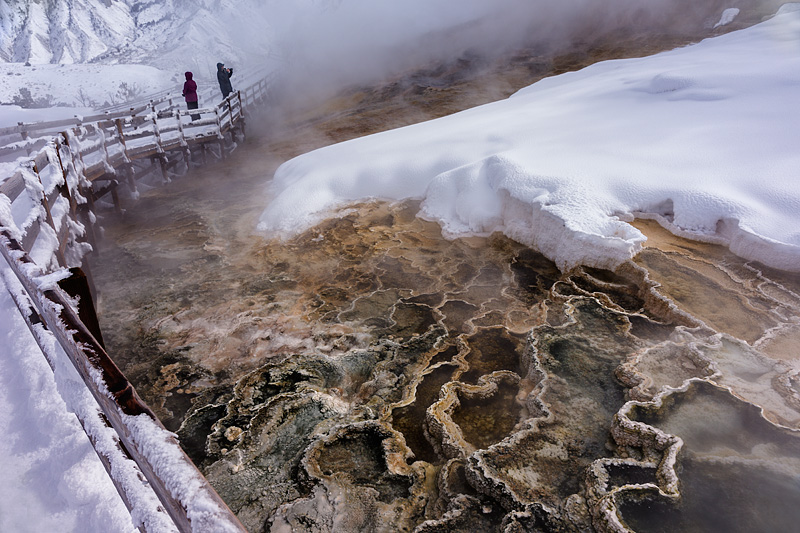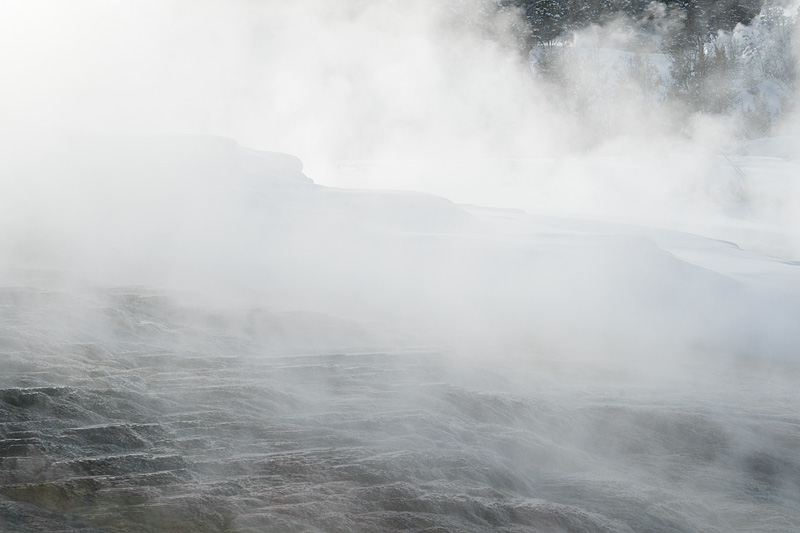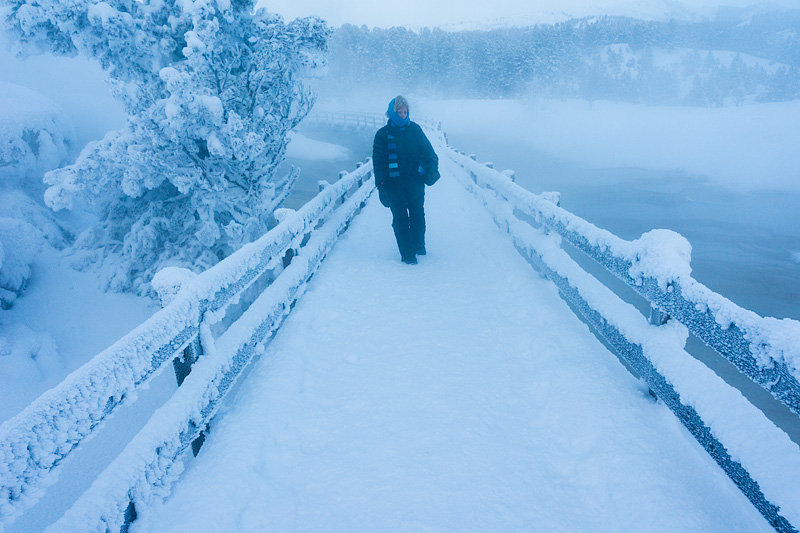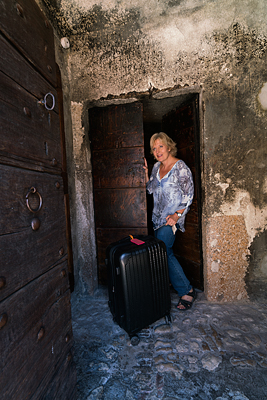

Photographing Yellowstone in winter may not be everyone’s cup of tea…but if you’ve followed my posts you’ll know that winter is my favorite time to photograph Yellowstone…when frost coats boardwalks and deep snow blankets the ground, creating a stark contrast to the colorful mineral springs and textured thermophiles that flow among the terraces. But the thick fog and steam from the icy air mixing with the geysers and volcanic heat sources in this magical place can be challenging—weaving in and out, obstructing the views—making you work harder to see and capture the geothermal features you know are there.


Here are some random tips from my recent 4 night stay in Mammoth Hot Springs in late February:
Clothing
Yellowstone is colder than you’ll expect. Dress for it. Located at an elevation of 8,000 ft it can be below zero here when it’s 40 degrees warmer in Bozeman just 2 hours away. Pay careful attention to your hands, face and feet. Once you’re cold, you’ll be tempted to stay inside by the fireplace sipping something to make you forget your frostbite. But if you bring the right clothes, you’ll stay toasty outside!
Boots: Baffin boots with 1 pair thick socks kept my toes toasty in -38 F degree temps. Yaktraks on the bottom of my boots helped with traction on the icy snowy boardwalks and the many staircases covered in deep snow that you basically slide down (using the railing to brace your balance). Hands: used “38 Below” metallic glove liners + knit gloves + windproof oversized mittens + handwarmers. For shooting, I took off my right mitten and still had a knit glove to protect me from touching cold metal on my tripod or camera. Most days this combination worked well, but the coldest day had an icy wind that proved too challenging, and my fingers burned from pain despite having handwarmers inside my windproof mittens. (Which reminds me–have plenty of spare handwarmers with you. They are not reliable! Six out of ten packs didn’t activate any heat.) Head: I wore a wool hat that covered my ears and kept me warm. And was really glad I brought a fleece turtle fur neck warmer that fit snugly around my neck, or on colder days around my lower face to protect my skin from the wind. Other: Wore Arctic snowpants over fleece leggings, and a puffy winter coat over a fleece top. I never felt cold, except for my fingers on that one frigid subzero day. Keep in mind that the entrance to the main terrace boardwalks are just a 10 min walk from the hotel, but the boardwalks cover a distance of around 1.5 mile or so. Each time I went out to walk around the main terraces it took me 2-3 hours. Yep, that’s me in the thick foggy steam.


Gear
The constant threat of steam tainted with minerals made me leery of exposing my lenses to the elements. Usually I’m not one to use UV filters, but I did for this trip. Don’t forget to use the lens hood to help protect your lens from intermittent spray. And if your camera is not weather sealed, use a rain cover or even a large plastic bag to protect your camera if shooting in an area with lots of steam. I also used a Lowepro shoulder bag to zip my camera inside–handy when I was walking in deep snow (in case I fell) or when passing though “toxic” areas thick with sulfurous fog. Tripod was heavy and cumbersome to carry on long walks around the steep boardwalks. Used it twice. Was hoping to shoot nightscapes, but skies were always cloudy.


Lenses: personal preference here, but my favorite lenses for photographing Yellowstone in winter are my Sony 16-35mm and 70-200mm. Switching lenses outdoors in close proximity to all the steam is naturally not recommended. Better to decide in your hotel room what lens you want for that morning/afternoon. Don’t forget to expose for snow–in manual mode meter +2 stops.
Wide angle lenses, such as 16-35mm, allow you to get really close to a feature and include the expansive view in the background and people for scale. Such as the opening picture shot at 16mm.
Telephoto lenses, such as 70-200mm, let you zoom in on an element to focus on pattern, color or texture.
Perspective: change your view.
Get close. Get low. Lie on the ground and shoot under the boardwalk railing to emphasize the form of a travertine pool.


Shoot through bare tree branches of a skeleton killed by the heat of the springs. Include people for a sense of scale. Or just their shadows.


Steamboat Geyser, Yellowstone National Park
Timing: when you shoot matters more on clear days, when the sun is visible at sunrise and sunset. During my 4 days I did get up early and stayed out late attempting to capture both, but it stayed cloudy and snowy. This was the only dawn that I saw a teensy bit of color in the clouds.

 If you are luckier than me and actually see color in the skies, head for Minerva Springs to shoot the pink-orange-magenta clouds reflected in the mineral pools of the travertine terraces. And send me a picture!
If you are luckier than me and actually see color in the skies, head for Minerva Springs to shoot the pink-orange-magenta clouds reflected in the mineral pools of the travertine terraces. And send me a picture!
Extremely cold days (below zero): beware that steam turns into thick icy fog and that the features become invisible. Go back different times to see varying views or wait for the clouds to dissipate.


Canary Springs barely visible through the fog
I visited Canary Springs 3 times before I could see anything through the fog, and used a telephoto to zoom in on the details.


Subject: The whole area can be overwhelmingly beautiful in person, but frustrating to capture in a single photo. What to do? Try narrowing the focus to one element verses including the entire scene. Here I just shot a tiny little pool in the snow rather than include the mountains in the background and surrounding grassy springs.


Or zero in on a pattern, texture or color. If the sun is out, use side lighting to bring out the textures.




Show interaction between an animal and the landscape. What do bison think of the geysers? They congregate around Old Faithful and sleep in the warm steam. At Mammoth Hot Springs, look for elk to show up around the hotel at dusk.


Capture the mysterious atmosphere of the foggy springs or show people emerging from the steam. And if there’s any sun, position yourself to shoot the steam being backlit to give it added dimension.

 Post Processing: Final tip has to include the finishing touch of making images come to life as you saw it. Straight out of camera RAW files will look very flat. I typically adjusted the contrast, exposure and blacks, and at times added a little clarity. Experiment with the color temperature sliders to adjust warm verses cool tone.
Post Processing: Final tip has to include the finishing touch of making images come to life as you saw it. Straight out of camera RAW files will look very flat. I typically adjusted the contrast, exposure and blacks, and at times added a little clarity. Experiment with the color temperature sliders to adjust warm verses cool tone.
Don’t let the cold keep you from visiting Yellowstone in winter. With a little planning, you can capture the beauty and mystery in this intriguing national park.
[booking_product_helper shortname=”yellowstone”]
~~~~~~~~~~~~~~~~~~~~~~~~~~~~~~~~~~~~~~~~~~~~~~~~~~~~~~~~~~~~~~~~~~~~~~~~~~~~~~~~~~~~~~~~~~~~~~~~~~~~~
Pin it! Pick your favorite pic to pin on your Pinterest travel board.


.jpg)

Stewart - Wow, nice photos. Cold photos, haha.
admin - yes, cold…but makes for interesting steam!! 😉